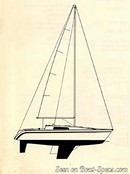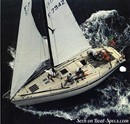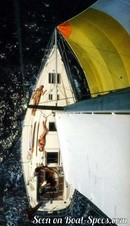First 35 - Berret Deep draft
Sailboat specifications
The First 35 - Berret is a 34’10” (10.6m) cruiser-racer sailboat designed by Jean Berret (France). She was built between 1979 and 1984 by Bénéteau (France) with 419 hulls completed. The Deep draft version displays a deeper fin allowing a lower center of gravity and extra performance especially upwind.
The First 35 - Berret is as well listed, on Boat-Specs.com, in Shoal draft version (see all the versions compared).
The First 35 - Berret is as well listed, on Boat-Specs.com, in Shoal draft version (see all the versions compared).
First 35 - Berret's main features
- Model
- First 35 - Berret
- Version
- Deep draft
- Hull type
- Monohull
- Category
- Cruiser-racer sailboat
- Sailboat builder
- Sailboat designer
- Sailboat range
- Country
- France
- Construction
- GRP (glass reinforced polyester):
- Hull: Single skin fiberglass polyester
- Deck: Sandwich balsa fiberglass polyester - Number of hulls built
- 419
- First built hull
- 1979
- Last built hull
- 1984
- Appendages
- Keel : fin without bulb
- Helm
- Single tiller
- Rudder
- Single spade rudder
- Unsinkable
- No
- Trailerable
- No
- Former French navigation category
- 1
- Standard public price ex. VAT (indicative only)
- N/A €
First 35 - Berret's main dimensions
- Overall length
- 35’ 1”10.7 m
- Hull length
- 34’ 10”10.6 m
- Waterline length
- 30’9.15 m
- Beam (width)
- 12’ 1”3.7 m
- Draft
- 6’ 7”2.02 m
- Light displacement (MLC)
- 10494 lb4760 kg
- Ballast weight
- 4850 lb2200 kg
- French customs tonnage
- 12.30 Tx
First 35 - Berret's rig and sails
- Upwind sail area
- 763 ft²70.9 m²
- Downwind sail area
- 1375 ft²127.7 m²
- Mainsail area
- 300 ft²27.9 m²
- Genoa area
- 463 ft²43 m²
- Jib area
- 160 ft²14.86 m²
- Stormjib area
- 83 ft²7.71 m²
- Symmetric spinnaker area
- 1074 ft²99.8 m²
- Rigging type
- Sloop Marconi masthead
- Mast configuration
- Deck stepped mast
- Rotating spars
- No
- Number of levels of spreaders
- 2
- Spreaders angle
- 0 °
- Spars construction
- Aluminum spars
- Standing rigging
- 1x19 strand wire
First 35 - Berret's performances
- IOR ratingiIOR, or International Offshore Rule, was a measurement rule system used internationally for ocean racing. It allows boats of different sizes and designs to race each other fairly. Therefore, by comparing these values, we can have an indication of the relative speed of 2 boats.
- 26.0
- Upwind sail area to displacementiThe ratio sail area to displacement is obtained by dividing the sail area by the boat's displaced volume to the power two-thirds.
The ratio sail area to displacement can be used to compare the relative sail plan of different sailboats no matter what their size.
Upwind: under 18 the ratio indicates a cruise oriented sailboat with limited performances especially in light wind, while over 25 it indicates a fast sailboat. - 270 ft²/T25.06 m²/T
- Downwind sail area to displacementiThe ratio sail area to displacement is obtained by dividing the sail area by the boat's displaced volume to the power two-thirds.
The ratio sail area to displacement can be used to compare the relative sail plan of different sailboats no matter what their size. - 486 ft²/T45.13 m²/T
- Displacement-length ratio (DLR)iThe Displacement Length Ratio (DLR) is a figure that points out the boat's weight compared to its waterline length. The DLR is obtained by dividing the boat's displacement in tons by the cube of one one-hundredth of the waterline length (in feet).
The DLR can be used to compare the relative mass of different sailboats no matter what their length:
a DLR less than 180 is indicative of a really light sailboat (race boat made for planning), while a DLR greater than 300 is indicative of a heavy cruising sailboat. - 176
- Ballast ratioiThe Ballast ratio is an indicator of stability; it is obtained by dividing the boat's displacement by the mass of the ballast. Since the stability depends also of the hull shapes and the position of the center of gravity, only the boats with similar ballast arrangements and hull shapes should be compared.
The higher the ballast ratio is, the greater is the stability. - 46 %
- Critical hull speediAs a ship moves in the water, it creates standing waves that oppose its movement. This effect increases dramatically the resistance when the boat reaches a speed-length ratio (speed-length ratio is the ratio between the speed in knots and the square root of the waterline length in feet) of about 1.2 (corresponding to a Froude Number of 0.35) . This very sharp rise in resistance, between speed-length ratio of 1.2 to 1.5, is insurmountable for heavy sailboats and so becomes an apparent barrier. This leads to the concept of "hull speed".
The hull speed is obtained by multiplying the square root of the waterline length (in feet) by 1.34. - 7.34 knots
First 35 - Berret's auxiliary engine
- Engine(s)
- 1 inboard engine
- Engine(s) power (min./max.)
- 15 HP / 25 HP
- Fuel type
- Diesel
- Fuel tank capacity
- 26.4 gal100 liters
First 35 - Berret's accommodations and layout
- Cockpit
- Closed aft cockpit
- Cabin(s)
- 2
- Berth(s) (min./max.)
- 4 / 10
- Head(s)
- 1
- Freshwater tank capacity
- 114.9 gal435 liters
- Maximum headroom
- 6’ 2”1.9 m



Bénéteau First 35 - Berret sailplan - - 2/8
Picture extracted from the commercial documentation © Bénéteau
Picture extracted from the commercial documentation © Bénéteau


Bénéteau First 35 - Berret layout - - 3/8
Picture extracted from the commercial documentation © Bénéteau
Picture extracted from the commercial documentation © Bénéteau


Bénéteau First 35 - Berret sailing - - 4/8
Picture extracted from the commercial documentation © Bénéteau
Picture extracted from the commercial documentation © Bénéteau


Bénéteau First 35 - Berret sailing - - 5/8
Picture extracted from the commercial documentation © Bénéteau
Picture extracted from the commercial documentation © Bénéteau


Bénéteau First 35 - Berret sailing - - 6/8
Picture extracted from the commercial documentation © Bénéteau
Picture extracted from the commercial documentation © Bénéteau


Bénéteau First 35 - Berret cockpit - - 7/8
Picture extracted from the commercial documentation © Bénéteau
Picture extracted from the commercial documentation © Bénéteau


Bénéteau First 35 - Berret interior and accommodations - - 8/8
Picture extracted from the commercial documentation © Bénéteau
Picture extracted from the commercial documentation © Bénéteau
Similar sailboats that may interest you:
Sailboats
First built hull
Hull length
1980
31’ 6”9.6 m
1992
34’ 7”10.55 m
2002
35’10.68 m
1984
30’ 8”9.35 m
1980
31’ 6”9.6 m
1984
32’ 6”9.9 m
1981
30’ 4”9.25 m
1995
34’ 5”10.49 m
1983
34’ 7”10.55 m
1979
34’ 10”10.6 m
1997
31’ 2”9.5 m
2010
35’10.66 m
1985
37’11.27 m
1982
38’ 6”11.75 m
1985
39’ 4”11.99 m